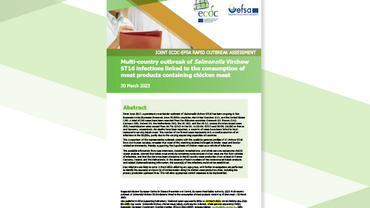Rapid Risk Assessment: Lassa fever in Nigeria, Benin, Togo, Germany and USA, 24 March 2016
This document assesses the risk of Lassa fever infection in Europe as a result of the ongoing outbreak of Lassa fever in Nigeria, Benin and Togo. Two imported cases from Togo have recently been medically evacuated to Germany and the United States respectively.
The document provides background information on Lassa fever virus, advice on the likelihood of secondary infection and prevention of transmission and travel advice for people going to or returning from West Africa.
Executive Summary
Following the spread of the disease to new areas in West Africa, Togo, and the risk of secondary transmission in healthcare facilities due to the delays in the diagnosis of viral haemorrhagic fevers, Lassa fever should be considered for any patient presenting with suggestive symptoms and with a travel history in West Africa, even with differential diagnosis, states the ECDC risk assessment.
Secondary transmission in healthcare settings (nosocomial transmission) should be prevented through appropriate infection control measures. Travellers to West Africa should be informed of the risk of exposure to Lassa fever virus and personal protective measures.
Imported cases of Lassa fever to Germany and USA
On 25 February 2016, a healthcare worker working in Oti district, Togo was transported to Cologne (Germany), with suspected malaria, and few days later died of severe multi-organ dysfunction. On 9 March 2016, Lassa fever was confirmed. A secondary transmission was confirmed on 15 March 2016 in a member of the company preparing the corpse for flight repatriation to the US.
On 18 March 2016, two additional contacts of the first case tested positive for Lassa virus. However, samples were later found to have been false-positive. Neither patient was ever PCR positive.
On 13 March 2016, CDC confirmed another case of Lassa fever in a surgeon medically evacuated to USA from the same district in Togo.
Current Lassa virus outbreaks in West Africa
Lassa fever is endemic in parts of West Africa including Sierra Leone, Liberia, Guinea, Nigeria and Benin. The disease was previously not reported in Togo. In 2016, there are ongoing outbreaks of Lassa fever in Nigeria, Benin and probably Togo.
However, neighbouring countries are also at risk, where the animal reservoir for Lassa virus, the ‘multimammate rat’, is spread.
The disease
Lassa fever is an acute viral haemorrhagic illness, endemic in West Africa. The Lassa virus is transmitted by the multimmamate rat.
The disease can be severe: although about 80% of those who become infected with Lassa virus have mild or no symptoms, one in five infections results in severe disease, death occurs in around 15–20% of the severe hospitalised cases.
The virus is present in rodent excreta and transmission occurs most commonly through ingestion or inhalation of contaminated items; it is also transmitted from human to human by contaminated blood.
Case assessment criteria include consumption of foods and drinks contaminated by rodent urine or droppings and exposure to multimmamate rats or to patients presenting with haemorrhagic fever.
ECDC risk and threat assessment
As transmission of Lassa virus mainly occurs through contact with bodily fluids or droplets, healthcare personnel involved in invasive care procedures are at increased risk of exposure. The risk level for secondary transmission depends on the closeness and duration of contact, on the type of activity performed by medical staff, as well as people handling or preparing the body of a person infected by Lassa fever (i.e undertakers), and on the personal protective equipment used.
Secondary transmission in healthcare settings (nosocomial transmission) should be prevented through ad-hoc isolation and using personal protective equipment, as well as transportation of patients with confirmed infection to specialised treatment centres.
Travellers to West Africa should be informed of the risk of exposure to Lassa fever virus, particularly in areas currently experiencing outbreaks. They should avoid consumption of foods and drinks contaminated by rodent droppings, exposure to rodents or to patients presenting with haemorrhagic fever.






